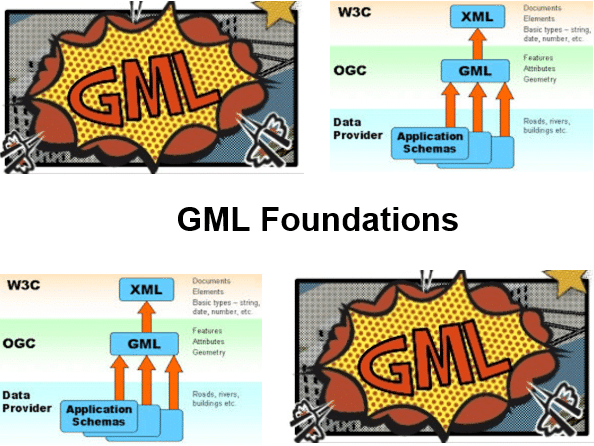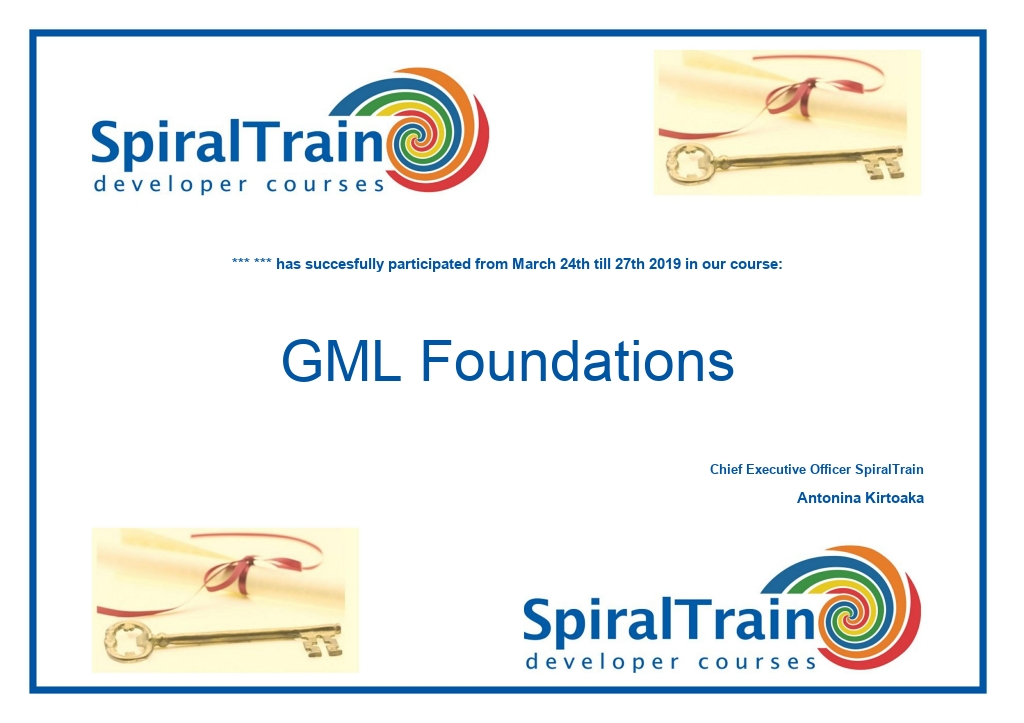-
Learning by doing
-
Trainers with practical experience
-
Classroom training
-
Detailed course material
-
Clear content description
-
Tailormade content possible
-
Training that proceeds
-
Small groups
In the course GML Foundations participants learn to deal with the OpenGIS Geography Markup Language Encoding Standard (GML).
GML is an XML vocabulary to express geographic properties. GML is not only a modeling language for geographic systems, but also an open standard for geographic transactions over the Internet.
Like all XML vocabularies the GML grammar has two parts: an XML Schema that describes the document structure and instance documents that describe the actual data.
In the course different variants of GML syntax are discussed such as INSPIRE GML and AIXM5 GML.
The course starts with an overview of the basic concepts of XML such as the XML document structure, the XML syntax rules and the difference between well formed and valid documents. The role of XML Namespaces is also discussed here.
Subsequently the XML Schema standard is discussed, which defines the naming, sequence and data types of XML instance documents based on a schema. The different styles of XML Schema construction and the definition of simple and complex user defined data types are discussed.
Then attention is paid to the GML data model with the Features, Geometry, Topology and Temporal Schemas. And also the GML domain vocabulary with Spatial Values, Object Property Rules, Associations and the role of Attributes is discussed.
An explanation of GML components such as Points and Curves, Surfaces and Solids, Nodes, Edges, Faces and Curve Segments are also part of the course program. This also includes Surface Patches, Interpolated Curves, Coverages and Surface Interpolation.
Finally the GML Coordinate Systems with CRS Dictionary Entries, Units of Measure and Quantity Types and GML Modeling with Schema Repositories, Substitution Groups and Schema Modularization are discussed.
The course GML Foundations course is intended for analysts and developers who want to learn the basics of GML and apply GML in geographic information systems.
Basic knowledge XML is required to participate in this course.
The theory is discussed on the basis of presentation slides. The theory is explained further by means of practical demos. After discussing a module, there is the possibility to practice. Course times are from 9.30 to 16.30.
Participants receive an official certificate GML Foundations after successful completion of the course.

Module 1 : XML Review |
Module 2 : XML Schema |
Module 3 : GML Model |
|
Structured Documents XML as Meta Language XML Document Structure XML Elements and Attributes Well Formed Documents Valid Documents Processing Instructions Entity References CDATA Sections Character References Namespaces XML Presentation XML Transformation |
Use of XML Schema Well Formed versus Valid XML Schema Components XML Schema Vocabulary XML Schema-instance Simple and Complex Types Design Approaches Salami Slice Design Russian Doll Design Venetian Blind Design XML Schema Data Types Global and Local Declarations Annotating Schema's |
Core Schema Components Features Schema Geometry Schema Topology Schema Temporal Schema Metadata Domain Vocabulary Spatial Values Object Property Rule RDF as Reference Associations Remote Properties Role of Attributes |
Module 4 : GML Components |
Module 5 : Coordinate Systems |
Module 6 : GML Modeling Rules |
|
Points and Curves Surfaces and Solids Surface Patches Interpolated Curves Surface Interpolation Curve Segments Topology Primitives Nodes, Edges and Faces Coverages Domain Sets Range Set Grid Function |
CRS Reference System GML Attribute srsName CRS Dictionary Entries New CRS Components Temporal Components Dynamic Features Abstract Feature Type Temporal Primitives Temporal Reference Systems Units of Measure Base Unit Dictionaries Quantity Types |
Feature Types Feature Collections Spatial Types Spatial Properties Managing Namespaces Import versus Include Versioning Schema Repositories Substitution Groups Schema Modularization Derive by Extension Derive by Restriction |
